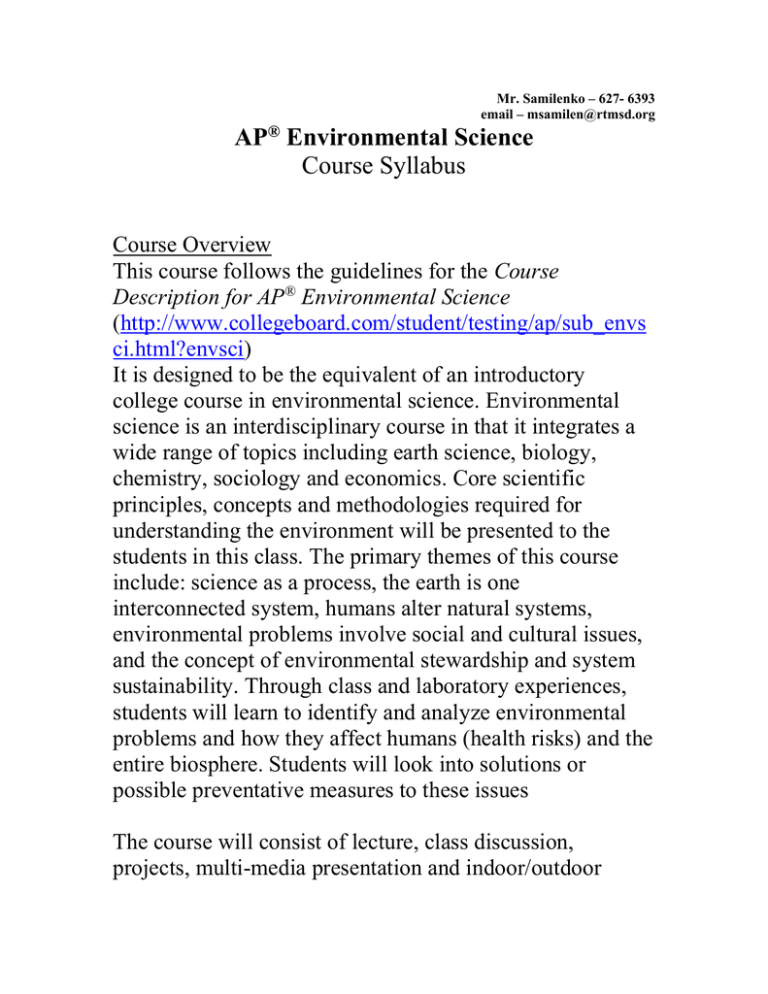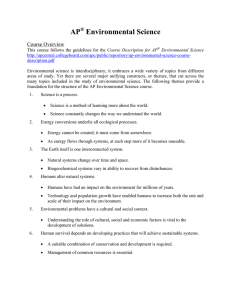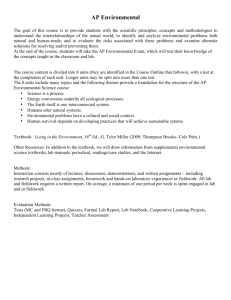AP Environmental Science Course Syllabus
advertisement

Mr. Samilenko – 627- 6393 email – msamilen@rtmsd.org AP® Environmental Science Course Syllabus Course Overview This course follows the guidelines for the Course Description for AP® Environmental Science (http://www.collegeboard.com/student/testing/ap/sub_envs ci.html?envsci) It is designed to be the equivalent of an introductory college course in environmental science. Environmental science is an interdisciplinary course in that it integrates a wide range of topics including earth science, biology, chemistry, sociology and economics. Core scientific principles, concepts and methodologies required for understanding the environment will be presented to the students in this class. The primary themes of this course include: science as a process, the earth is one interconnected system, humans alter natural systems, environmental problems involve social and cultural issues, and the concept of environmental stewardship and system sustainability. Through class and laboratory experiences, students will learn to identify and analyze environmental problems and how they affect humans (health risks) and the entire biosphere. Students will look into solutions or possible preventative measures to these issues The course will consist of lecture, class discussion, projects, multi-media presentation and indoor/outdoor laboratory investigations. Assessments will be in the form of laboratory reports, weekly quizzes, exams, and projects. A final exam will constitute the fifth marking period. The topics covered in this course also aim in preparing students for the AP® environmental exam in May. Students will be expected to read from the text and/or from supplemental reading weekly, in preparation for the class. Vocabulary and essay study guides will be constructed as a learning tool by the students in preparation for exams. Assignments and materials are found on my web page. Text Miller, G. Tyler. Living in the Environment: Principles, Connections, and Solutions. 18th ed. Pacific Grove, Calif.: Brooks/Cole. Course Outline The following outline is organized in units and by marking period. 1st Quarter Marking Period Overview of environmental science Overview of issues and sustainability Review of science as a process Experimental design Basic chemistry and physics (thermodynamics) Chapters 1 ,2 Ecosystems (living world) Energy flow Matter cycles Biodiversity Natural selection and evolution Biomes Communities Succession Chapters 3, 4 2nd Quarter Marking Period Population Ecology Biological concepts of population Human population (dynamics, sustainability, impacts of growth) Chapters 8, 9 Biodiversity Sustainability Terrestrial diversity Aquatic diversity Ecosystem Approach Species Approach Chapters 7, 8, 9, 10, 11, Land and water use Agricultural practices (crop production, erosion control, pest control, overgrazing, land management) Sustainable agriculture Forest management Water resources (fishing, aquaculture, wetlands, aquatic ecosystems) Geological nonrenewable resources Chapters 12, 13, 14 3rd Quarter Marking Period Energy Resources Energy consumption (global use and future needs) Fossil fuels Nuclear energy Hydroelectric Renewable energy and renewable fuels Energy conservation Chapters 15, 16 Pollution Health hazards and risks Ozone depletion Climate change Air, water, solid and noise pollution (types, sources, causes,) Effects on the environment Hazardous wastes Chapters 17, 18, 19, 20, 21, 4th Quarter Marking Period Global Sustainability Review of resources conservation Ecological services and ecosystem monitoring Environmental policy Environmental law Economic systems and sustainability Environmental worldviews and ethics Chapters 22, 23, 24, 25, AP Exam – May 4th 2014 Final Exam Laboratory Investigations The purpose of laboratory investigation is to allow students to observe and have direct experiences with organisms or systems in the environment. This also allows for students to gain sampling skills and data collection techniques as well as other scientific methodologies. It also allows for data manipulation (calculations), interpretation and inquiry. From these experiences students will think analytically in order to make conclusions. Students can then evaluate the validity of their findings to propose solutions to problems and further questions for study. Laboratory investigation will range from in class experiments and investigation to field laboratories and investigations. The following is a list of laboratories. Weather conditions and time restrictions limit the completion of all the following activities. Many of these activities may take several weeks to complete and therefore cover more than one laboratory period. First Semester (marking periods 1 and 2) (subject to change) Ecological succession – Students walk the property of nearby park to find and photograph various stages of ecological succession. This will then be put into powerpoint presentations. Mark – return – recapture of grasshoppers - Students visit a nearby meadow and capture and tag grasshoppers. They then come back the following week to recapture them to do a population study. Tree species Survey – Students will be given a set area of forest in which they will identify species and group them by crown class in order to determine the structure of the forest. Evolution and Adaptation with Wooly worms – Students will collect data on a simulated wooly worm population to determine adaptations such as cryptic coloration and calculate a chi-square test. Forest study field assistants - Students will prepare an instructional video for the freshman environmental science students on tree identification and forest quadrant procedures. They will also assist the freshman the day of the study. Exponential Growth – Students will use data to determine exponential growth of a population Wildlife Management –Students will create a report regarding a real life scenario on coyotes and wildlife management. Living soil – Students will create a mini subterranean ecosystem with earthworms and other soil organisms in order to see their affects on the composition of soil over time. Animal adaptations and recognizing animal sign – Students will identify skulls, tracks, and furs of wildlife and relate their physiology to their feeding adaptations and habitat. Reintroductions and age structure – Students will use age structure diagrams of two National Forests to determine the best choice for Lynx reintroduction. Choosing a pesticide – Students will choose a specific pesticides or pest management approach for specific pest control situation through research. Designing a conservation plan for a housing development – Students will be given a scenario for a housing development in which they will have to present a plan for its development incorporation various conservation techniques. Designing a model ecosystem – Students will do an indepth group research study of an ecosystem in order to design a model ecosystem. The design will be presented with visual displays and models. Hawk Mountain (Tentative) – Visit hawk mountain where students will learn how to identify various raptors and study migrations patterns Second Semester (marking periods 3 and 4) (subject to change) Human Population – Students will understand some of the basic concepts of population demography - survivorship and mortality from a local cemetery Biodiesel– Students will create their own biodiesel form vegetable oil. Soil analysis – Student will test soil in various parameters including texture, porosity, invertebrates, moisture content, percolation rate, and fertility. Watershed mapping – Students will use various maps of the area in order to trace their local watershed through increasing stream order until it reaches the ocean. Visit to a water treatment plant – Students will visit a local water treatment plant in order study the various process involved water treatment. Testing tap water – Students will be testing tap and other water sources for hardness and pH in order to compare and discuss the their quality. Sewage Treatment Plant – Students will build a small sewage treatment plan in a two-liter bottle in order to see how a sewage treatment plant works using real world parameters The effects of nutrients on a mini-pond ecosystem Students will create miniature pond ecosystems in order to observe the effects of eutrophication on an aquatic ecosystem. Algae and water pollution - Student swill study preserved slides of algae and evaluate the pollution tolerance of the various species of algae. Particulates Air pollution – students will measure particulate matter in and around the building and evaluate the data by EPA standards Acid Rain – Students will measure and compare pH levels in precipitation of areas over tie and analyze and account of varying concentrations of oxides and pH reading in precipitation Invasive hike and management proposal – Students will take a walk on the campus or nearby park in order to identify various invasive species and their effects on native species. They will then prepare a management plans and report for the school on dealing with this issue



